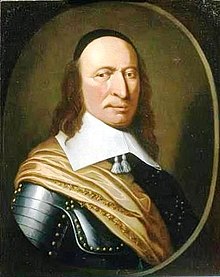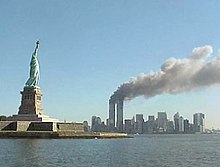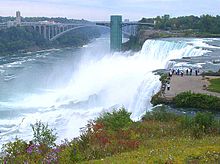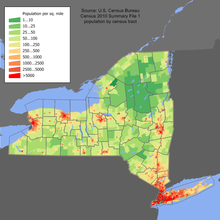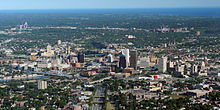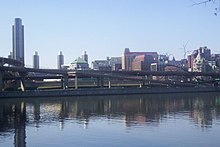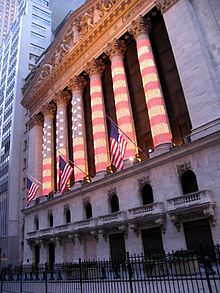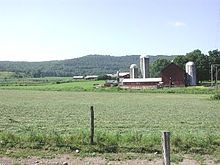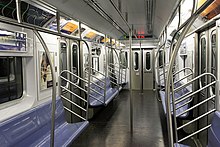New York (state)
New York is one of the fifty states that, together with Washington D.C., make up the United States of America. Its capital is Albany and its most populous city, the homonymous New York.
It is located in the Northeast region of the country, Mid-Atlantic division, bordered to the north by Lake Ontario and the St. Lawrence River, which separate it from Canada; to the east with Vermont, Massachusetts and Connecticut; to the southeast with the Atlantic Ocean; to the south with New Jersey and Pennsylvania; and to the west with Lake Erie and the Niagara River, which again separate it from Canada. With 19,795,791 inhabitants in 2015, it is the fourth most populous state (behind California, Texas and Florida) and with 137.14 inhab/km² it is the seventh most densely populated (behind Delaware, Maryland, Massachusetts, Connecticut, Rhode Island, and New Jersey). It was admitted to the Union on July 26, 1788, as the 11th state.
It is the largest financial and commercial center in the United States, as well as its largest industrial center.
Not to be confused with the city of the same name, New York City (official name: City of New York, or informally, New York City), located in the southern tip of the state. For this reason, the state is often called "New York State." New York City is not only the largest city in the state, with its 8.5 million people, about half the state's population, but also the largest city in the United States.
New York's nickname is the Empire State. Historians believe that this nickname comes from a comment made by George Washington who once commented that New York was the center of the American Empire. The state motto is "Excelsior," a Latin word meaning "always on top," "always on top," or "higher still."
New York was originally settled by the Dutch, who called the region New Netherlands (Nieuw-Nederland). They also founded a settlement on the island of Manhattan, called New Amsterdam. When England captured the state from the Dutch, the English renamed "New York" both the region and the city located in Manhattan. New York was one of the thirteen British colonies that rebelled in the American War of Independence. A third of all the battles of the war took place in this state.
After the war, New York became the 11th state to enter the Union, on July 26, 1788. It became the most populous in the country around 1810, although it was surpassed by California in the 1960s, by Texas in the 1990s, and by Florida in the 2010s.
History
European exploration and colonization
The region where New York State is located today was inhabited by two groups of Native Americans long before the arrival of the first Europeans in the region. These groups were the Iroquois and the Algonquins, who were rivals to each other. The Iroquois were more socially organized than the Algonquins, and had a notable political and social hierarchy, in addition to being more advanced militarily.
The first European to explore the region where New York State is now located was the Italian explorer and navigator Giovanni da Verrazzano, who was exploring on behalf of the French court, naming the region New Angoulême (Nouvelle Angoulême, in French), in honor of King Francis I of France. He reached the Hudson River around 1524.
In 1609, Englishman Henry Hudson, exploring on behalf of the Netherlands, sailed up the Hudson River, officially annexing the region to the Dutch. That region would come to be known as the New Netherlands. The Dutch established several trading posts in the region, and established trade relations with the indigenous Iroquois. In 1621, a group of Dutch merchantmen created a company, the Dutch West India Company. In 1624, the Dutch government gave the Dutch West India Company full rights to trade with the New Netherlands for 24 years. That same year, a first batch of settlers, about 30 families, were sent to the region, where they would found Fort Orange —which is the current capital of New York, Albany.
In 1625, the Dutch founded a town and began building a fort, both on the island of Manhattan. Both were called New Amsterdam, the town being the capital of the colony. The town of New Amsterdam would develop into present-day New York City. In 1626, the governor of the New Netherlands at the time, Peter Minuit, purchased the entire island of Manhattan from the natives living in the region by exchanging goods worth a total of about $24. During the following years, the Dutch would found various settlements and towns in the region of what is now the state of New York.
In 1629, the Dutch West India Company accelerated the process of colonizing the New Netherlands. He implemented a system of latifundia, by offering large tracts of land to the members of the Company, who would only continue to own their land if they managed to colonize their parcels with a certain number of settlers. Most failed to accomplish this goal, but one settler, Kiliaen van Rensselaer, achieved great success, settling the areas where Albany, Columbia, and Rensselaer counties now lie. Thanks to Rensselaer's success, this system, in which few latifundistas controlled large estates, renting smaller plots of land to farmers, who were obliged to cede a given percentage of their crops to owners, persisted until the 1840s, when a series of revolts put an end to this system.
1664-1790
During the 1640s and 1650s, many English settlers from the English colony of Connecticut settled on Long Island, part of present-day New York State. At first, relations between the English and Dutch colonists were friendly. However, these rapidly fell into disrepair in the late 1650s. King Charles II of England decided to conquer the New Netherlands, sending a naval fleet in 1664, which dropped anchor in the capital of the Dutch colony, New Amsterdam. The then Governor of the New Netherlands, Peter Stuyvesant, decided to surrender without resistance.
The "New Netherlands" were renamed "New York" by the English, in honor of the Duke of York. The name of the town from "New Amsterdam", for its part, would also be changed to "New York". The French settled in New France, which now includes eastern Canada, began to take an interest in northern New York in the English colony around 1680. French explorer René Robert Cavelier de La Salle would explore northern New York in 1669. In 1731, the French built a fort at Crown Point on Lake Champlain and claimed northern New York. In 1689, war broke out between England and France, and New York immediately became the scene of numerous clashes between the English and the French. These battles, which would become known globally as the French and Indian Wars, took place between 1689 and 1763. The English, clearly outnumbered, and supported by the native Algonquins, finally defeated the French, capturing New France in 1763.
British control of the North American colonies was a source of discontent among the population of New York State. In the 1730s, the journalist John Peter Zenger strongly criticized the British government, and was imprisoned for it. However, the jury, in 1735, found Zenger not guilty, pleading freedom of the press, which was a great victory for the American press.
People in the state were also dissatisfied with the taxes imposed on products made in the colonies or with the authority of English judges, and New York was one of the Thirteen British Colonies that rebelled against the United Kingdom in the War of Independence of the United States. During that war, about 30,000 people loyal to England left the colony. New York was the scene of several important battles, such as the Battle of Saratoga, although the city of the same name was captured immediately, early in the war, by the British, who left the city only after the end of the war.
On July 9, 1776, the New York Provincial Congress met in White Plains, definitively approving the Declaration of Independence of the United States of America, adopted by the Continental Congress five days earlier, July 4. New York ratified the Articles of Confederation on February 6, 1778.
The end of the Revolutionary War made it possible to develop the lands that now make up western New York State, which until then were not part of any of the former Thirteen Colonies. New York and Massachusetts claimed the region. By the Treaty of Hartford, of 1786, New York would have the right to land sovereignty, while Massachusetts would have the right to acquire the lands of the region from the Native Americans. Various groups tried to bypass the treaty, without success. A 999-year lease, signed in 1787, was quickly annulled by the New York and Massachusetts legislatures.
On April 1, 1788, the region was sold to Nathaniel Gorham and Oliver Phelps of Massachusetts for $1 million, to be paid in three annual installments. Gorham and Phelps, however, only acquired the property rights after purchasing these lands from the Native Americans who inhabited the region, and they immediately opened negotiations with the Native Americans of the region, thus having acquired the lands east of the Genessee River from the natives through the Treaty of Buffalo Creek, on July 8 of that same year. Gorham and Phelps, however, quickly ran into financial difficulties, and agreed to cede the lands west of the Genessee River to Massachusetts in 1790. On March 12, 1791, Massachusetts sold all of these lands to Robert Morris, who, in turn, immediately he sold them to the Holland Land Company. By the Treaty of Big Tree, signed in September 1797, Morris purchased the lands west of the Genessee from the Native Americans. In 1802, the Holland Land Company opened a sales office in Batavia, and began selling the region's land to third parties. The office still exists today, converted into a museum.
Meanwhile, during the planning process for the federal government system, New York opposed the installation of centralized government. After intense discussions between New York and other US states (or future states) on issues related to US government, New York agreed to ratify the Constitution of the United States of America on July 26, 1788, becoming the 11th..º State to be part of the Union. New York City was temporarily the nation's capital, from 1785 to 1790, when the national capital was permanently changed to Washington, D.C. In New York City, George Washington was inaugurated as the first President of the United States.
1790-1900
New York grew rapidly after independence from the United States, and by 1810, it was already the most populous state in the country, with a population of 959,000. However, the War of 1812 temporarily interrupted this period of growth. British troops invaded the United States from Canada, and some minor battles took place in the state. However, New York continued to prosper economically after the war. Many people came from other regions of the country, as well as immigrants from Canada, and many of them settled in the interior of the state. Thus, around 1820, New York already had 1,380,000 inhabitants, of whom about 500,000 lived in the far west of the state, a previously unpopulated border region. After the end of the war, many people from other parts of the state or the country began to settle in the border regions, still unpopulated or sparsely inhabited.
The construction of the Erie Canal made the state a major transportation hub, making New York City the largest port center in America, surpassing Boston and Montreal. Not only did the canal provide access to the interior of the state, but it also provided a shortcut between the Atlantic Ocean and the Great Lakes, connecting Lake Erie to New York Bay. Around 1850, New York was already firmly known throughout the country as the Empire State, and was the largest commercial, industrial, and population center in the United States.
In 1839, a great popular movement began against the system of large estates and land rentals. This system caused the indebtedness of many peasants who cultivated the lands of the latifundistas, since the percentages of the harvest that the former had to deliver to the latter were very high —around 60-70%. During the 1840s, numerous protesters, disguised as Native Americans, attacked these large estates. This movement, in its beginnings was only a popular demonstration, later it became a great political force in the state, and during the 1840s and 1850s, these large estates began to be fragmented into smaller independent farms.
In 1861, the American Civil War broke out. The majority of the state's population was against slavery. Many people, however, were against the forced military conscription, imposed by the US government in 1863. In July of that same year, popular riots took place over four days in New York City (the so-called Draft Riots), causing nearly 500 deaths and more than $1.5 million in damage. The riot ended with the arrival of US troops, who imposed order in the city.
From the 1860s onward, European immigrants—especially Italians, Germans, Irish, and Poles—began to settle en masse in the state, especially in New York City. Currently, Italian descendants are the majority ethnic group in the state.
1900-Today
On September 6, 1901, President William McKinley is assassinated at the Pan-American Exposition in Buffalo. Theodore Roosevelt, who had already served as governor of the state of New York in 1899 and 1900, was the Vice President of McKinley and assumed the presidency of the country.
New York prospered economically with and after World War I. Factories produced armaments and other military materials, and the port of New York became a major shipping hub for US troops to Europe.
New York State was hit hardest by the Great Depression in the 1930s—especially New York City. The unemployment rate in the cities rose dramatically (30% or more), wages fell, and there was massive price deflation—not counting side effects, like homelessness, resulting from non-payment of rent, for example. In the field, the situation was no better. Farmers had no money and debts were piling up.
The onset of US involvement in World War II ended the negative effects of the Great Depression once and for all, and the state immediately returned to prospering economically. After the end of World War II, the headquarters of the United Nations Organization is built in New York City, and it achieves the status of capital of the world economy, since it previously corresponded to the English city of London. With the end of the war, and the start of the Korean War in 1950, New York became one of the largest producers of war materiel in the country.
During the late 1950s, New York, in a joint program with the Canadian province of Ontario, began construction of numerous dams on the St. Lawrence River and the Niagara River. In 1959, the San Lorenzo Canal was inaugurated, which allowed the safe traffic of ships between the Atlantic Ocean and the Great Lakes. During the 1960s, New York's highway system underwent a major expansion, and two new major interstate highways were opened, one linking Pennsylvania to Canada, the other linking Albany to the Canadian province of Quebec.
Around the 1970s, many factories in the state closed, moving to other states like California or Texas, or even to other countries where labor was cheaper. This caused a drop in the population of the state. Although, on the other hand, new factories, usually high-tech, were installed in New York State in the 1980s, and the state's population began to grow again, thanks in part to the large immigration of Hispanics and Asians, immigration that continues today.
Physical geography
New York State is bordered to the west by Lake Erie, to the north by Lake Ontario as well as the Niagara River and the Canadian provinces of Ontario and Quebec, to the east by the US states of Vermont, Massachusetts and Connecticut, to the southeast with the Atlantic Ocean and to the south with New Jersey and Pennsylvania. In addition, it also borders the state of Rhode Island, although only through a water border.
In the state of New York is located the only international extraterritorial enclave within the United States, the UN Headquarters.
Southern New York State—consisting of New York City and its suburbs including Long Island and the southern part of the Hudson River Valley—can be considered the central core of a megalopolis, a supercity that is stretches from Boston to Washington DC, often called BosWash. The state of New York is closely associated with the city of the same name, although this is not its only aspect. The rest of New York state is dominated by farms, forests, rivers, mountains, and lakes. One of the best-known tourist attractions in New York —as well as in the United States— is Niagara Falls, located in the northwest of the state, next to the Canadian border.
To the east of New York City lies an island—appropriately named Long Island, since it is about 120 miles long—occupied by Nassau and Suffolk counties. Trees have been of great importance throughout the history of the state and New York City, and have made important contributions to the state's economy. Currently, it is possible to see tall trees even in the New York metropolitan area. One of them, the Queens Giant, is the tallest and oldest tree in the region.
New York's coastline is about 204 kilometers long. Counting all the regions washed by the sea—bays, estuaries, and oceanic islands—this number increases to 2,977 kilometers. New York has nearly 2,000 lakes and ponds, and its forests cover about half the state.
Maps
Geographic Regions
We can divide New York into eight different geographic regions:
- The Atlantic coastline are located at the southern end of the state, in Long Island and in Staten Island. They are located practically at sea level, and are characterized by their flat and uneven terrain. The Coastal Plains are the most populous regions in the state. In this region, fishing and agriculture are of great importance.
- The Hudson-Mohawk Plains are valleys that comprise most of the Hudson River. They are 16 to 50 kilometres wide, providing the only viable means of hydrographic transport between the Apalaches.
- La Meseta de New England is a region of low mountains and mountains that extends across the southeast of the state, cut by the final stretch of the Hudson River. New York City is located in this region.
- Them Montes Adirondack They are located north of the state. Its format is circular, with a diameter of approximately 160 kilometers. They are characterised by their soil extremely old and resistant to erosion. Here is the highest point of the state, Mount Marcy, with its 1629 meters of altitude. Another 40 peaks in the region exceed the mark of 1200 meters high.
- The Sierras Tug are an isolated area in the state, a plateau whose terrain is relatively uneven, with an average altitude of 120 to 200 meters above sea level. They are located south of the Adirondack Mountains.
- The Plains of the Great Lakes are located in the northwest of the state, next to Lake Erie and Lake Ontario. Here are the famous Niagara Falls. They are characterized by their fertile soil, their very uneven terrain and low altitudes.
- The Plains of San Lorenzo are located in the north and in the north-east end of the state, along the San Lorenzo River. Its valley is about 28 kilometers wide. They are characterized by their very fertile soil, their very uneven terrain and their low altitudes.
- La Plateau of the Apalaches covers the entire southwest portion of New York, and is the largest of the geographical regions of the state. Its altitude is medium, and varies between 240 and 650 meters high. It is characterized by its rocky and rugged terrain. It's the least populated region in the state.
Climate
New York's climate is temperate, although the rigors of the climate vary widely, depending on the region. The average winter temperature is -10°C in the Adirondacks, and 0°C in New York City. In summer, the average temperature in the Adirondacks is 19°C, and 23°C in New York City.
The highest temperature recorded in the state was 42 °C, in the city of Troy, on July 22, 1926. The lowest temperature recorded, not counting the wind chill, was -52 °C, at Old Forge, on February 18, 1979.
Hail and frost are common in the state. The Adirondacks are susceptible to frost for about 250 days a year, while Long Island is susceptible to frost for only 100. The state's average annual precipitation rate is 1,470 millimeters.
| New York City | |||||||||||||
|---|---|---|---|---|---|---|---|---|---|---|---|---|---|
| Month | Ene | Feb | Mar | Abr | May | Jun | Jul | Ago | Sep | Oct | Nov | Dic | Year |
| Average maximum temperature (°C) | 4 | 7 | 10 | 15 | 22 | 27 | 30 | 29 | 24 | 18 | 12 | 6 | 17 |
| Average minimum temperature (°C) | -3 | -1 | 2 | 7 | 12 | 17 | 20 | 19 | 16 | 10 | 5 | -1 | 8 |
| Precipitation (mm) | 86 | 84 | 99 | 102. | 112 | 95 | 112 | 104 | 99 | 91 | 127 | 99 | 1124 |
| Source: Weatherbase | |||||||||||||
Demographics
|
|
According to the 2010 census data, New York had a population of 19,378,102, making it the fourth largest population of the 50 United States, behind only California, Texas, and Florida. Its population increased by 401,645 (2.1%) compared to the year 2000.
The population increase since the year 2000 is due to a natural growth of 527,876 people (1,345,482 births minus 817,606 deaths) and a net migration of 334,093 people in the state. External migrations have resulted in a net increase of 667,007 people, while internal migrations produced a net loss of 502,155 people.
New York State is home to one of the most diverse populations in the United States, especially New York City, arguably the most multicultural city in the world. In 2004, 20.4% of New York residents were not born in the United States.
New York is currently experiencing low natural growth rates. This is primarily due to the large migration of the state's residents to the southern and western United States, continued job losses, and the state's high cost of living. New York recently lost the position of the third most populous state in the country to Florida, in the late 2010s.
Most of New York's population lives within two hours of New York City. According to Census Bureau data as of July 1, 2004, New York City and its six New York State satellite counties (Suffolk, Nassau, Westchester, Rockland, Putnam, and Orange) have a total of population of 12,626,200 inhabitants, 65.67% of the state's population.
| Graphics of Demographic Evolution of NewYork between 1790 and |
 |
Races and Ethnicities
As of the 2010 census, New York State had a racial makeup of:
- White: 65.7 %.
- Black or African American: 15%.
- Asian: 7.3 %
- Native Americans: 0.6 %.
- Other races: 7.4%.
- Two or more races: 3.0%.
The population of Latino or Hispanic origin represented 17.6% of the total population of the state in 2010. This population is the fastest growing, due to the high fertility rate of Latina women residing in the States United States, and also due to legal and illegal immigration from Latin America and the Caribbean.[citation needed]
The four largest ethnic groups in New York are White (60.2%), Latino (16.3%), Black (15.5%), and Asian (6.9%).
New York is home to the largest Dominican (concentrated in Upper Manhattan) and Puerto Rican (concentrated in the Bronx) populations in the country. Brooklyn and the Bronx contain a large population of African Americans. For its part, Queens has a large population of Latin American origin (highlighting the Ecuadorian community), as well as the largest Asian-American population in the state.
The 2000 Census provides data such as which ethnicities are most present in a given county. Italian Americans are in the majority on Long Island and Staten Island, followed by citizens of Irish descent. The latter make up the largest ethnic group in Manhattan, followed by those of Italian descent. Both groups have a large presence in Albany and South Central New York. By contrast, in Buffalo and western New York, the largest group is German-Americans. Finally, the northern tip of the state is dominated by French-Canadians. New York State has more Italian Americans than any other state.
Pyramid of ages
The age distribution of the population in 2000 was:
- Less than 5 years: 6.5%
- Under 18: 24.7%
- Over 65 years: 12.9%
- Between 19 and 64 years: 55.9%
Female people make up approximately 51.8% of New York's population.
Religion
| Religion in New York (2019) |
|---|
| Catolicism 31% Irreligion 27% Protestantism 26% Judaism 7% Other than 7 per cent Islam 2% |
| Catholics | 7 268 880 |
| Protestants | 7 816 000 |
| Orthodox Christians | 195 400 |
| No religion | 3 517 200 |
| Other Religions | 742 520 |
| 1990 | 2000 | % change | |
|---|---|---|---|
| No religion | 7.0% | 13.4% | +92% |
| Catholics | 44.3 per cent | 38.4 per cent | -13% |
| Protestants (main line) | 14.4% | 13.4% | -7% |
| Baptists | 8.3 per cent | 7.4% | -10% |
| Pentecostal | 1.7% | 2.8% | +63% |
| Mormons | 0.2 per cent | 0.2 per cent | -13% |
| Other Protestant affiliations | 1.7% | 1.6% | -6% |
| Christians (not specified) | 9.5% | 7.7% | -19% |
| Total Christianity | 80.1 per cent | 71.5% | -5% |
| Jews | 6.9% | 5,0% | - 27% |
| Muslims | 0.8% | 1.9% | +132% |
| Buddhists, Hindus, Sikhs | 0.8% | 1.7% | +116% |
| Other religions | 1.5% | 1.0% | -32% |
| NS/NC | 2.9% | 5.5 per cent | +89% |
Urban network
New York State is highly urbanized. Of the total population in the 2010 census, 87.87% of the state's population lived in urban areas and 12.13% in rural areas. 92% of the state's population lives in one of the thirteen New York metropolitan areas. Of these 13 metropolitan areas, three of them have more than one million inhabitants: New York, which is also the largest city in the United States and comprises about two-fifths of the state's population, Buffalo and Rochester. Five cities in the state have more than 100,000 residents: New York, Buffalo, Rochester, Yonkers, and Syracuse.
Main cities
The cities with the largest populations in the state are:
| # | City | Population (2010) |
|---|---|---|
| 1 | New York | 8 175 133 |
| 2 | Buffalo | 261 310 |
| 3 | Rochester | 210 565 |
| 4 | Yonkers | 195 976 |
| 5 | Syracuse | 145 170 |
| 6 | Albany | 97 856 |
| 7 | New Rochelle | 77 062 |
| 8 | Mount Vernon | 67 292 |
| 9 | Schenectady | 66 135 |
| 10 | Utica | 62 235 |
| 11 | White Plains | 56 853 |
| 12 | Niagara Falls | 50 193 |
| 13 | Troy | 50 129 |
| 14 | Binghamton | 47 376 |
| 15 | Rome | 33 725 |
Economy
New York City dominates the state's economy. It is the main banking, financial and telecommunications center of the United States, and is also the headquarters of the New York Stock Exchange (NYSE) on Wall Street, Manhattan. The United States Government's Bureau of Economic Analysis (BEA) estimates the state's 2004 gross domestic product at $1,115,783 million. This places it in third place of the US, behind California and Texas. If New York were a nation, it would rank as the 13th largest economy in the world, behind South Korea. The state economy grew that same year by 7.3%, slightly faster than the US growth rate (4.5%). In 2005, it was ranked as the 11th largest state in the US in terms of speed of economic growth. Also in that year, its per capita income was $51,507, an increase of 8.9% over last year's data, ranking it 5th in the nation (behind Maryland), and 8th in the world (behind Ireland). The main products of New York are milk and its derivatives, cattle (especially beef), vegetables, nursery products and apples. On the other hand, among the main industrial activities and products are the press, scientific instruments, electrical equipment, machinery and chemical products.
Many of the world's major corporations have their headquarters in Manhattan or nearby Westchester County. The state also has a thriving industrial sector, where we can cite activities such as the manufacture of garments, skins, rolling parts of the railways and the assembly of buses. Certain industries are also concentrated in the north of the state, such as ceramics, microchips and nanotechnology (Albany), and photographic equipment (Rochester).
There is some commercial fishing activity, not too large, that is located along the Atlantic seaboard of Long Island. The main catches by value are clams, lobsters, squid and flounder. Oysters used to be fished in New York waters as well, although these only comprise a small part of the total value of all shellfish caught today. Perhaps the most well-known aspect of the fishing industry is New York City's famous Fulton Fish Market, which distributes not only New York catch, but all manner of imported seafood from all over the world.
New York's mining industry is concentrated in three areas. The first is located near New York City, and specializes in construction materials for city works, although it also includes the Westchester County emery mines, one of two places in the US where emery is extracted. this ore. The second area is located in the Adirondack Mountains, and specializes in talc, industrial garnets, and zinc. It should be noted that these mountains are not part of the Appalachian system despite their position, but structurally belong to the Canadian Shield, abundant in minerals. In the interior southwestern part of the state, in the Allegheny Pleateau, is a region of wells. The main and, almost only, liquid that is extracted is salt in the form of brine, although there are also small oil reserves.
New York exports a wide variety of goods, such as food products, mineral products, processed goods, diamond cutting, and auto parts. In 2004, New York's top 5 export markets were Canada ($30.2 billion), the United Kingdom ($3.3 billion), Japan (2.6 billion), Israel ($2.4 billion), and Switzerland (1.8 billion). New York's main imports are oil, gold, aluminum, natural gas, electricity, rough diamonds, and lumber.
Canada has always been an important economic partner of New York. According to 2004 data, 23% of the state's total exports went to Canada. Tourism from the north comprises an important part of the state's economy. It is estimated that Canadians spent a total of $487 million on their visits to the state in 2004. This figure is expected to increase due to the strength of the Canadian dollar.
Agriculture
New York State is an agricultural leader, ranking in the top five states in the US for production of agricultural products. Notable among these are milk, apples, cherries, cabbage (the state is the largest producer of cabbage in the US), potatoes, onions, maple syrup, and many others. About a quarter of the state is covered by farms, and it produced $3.4 billion in agricultural produce in 2001. The southern shore of Lake Ontario provides the right mix of soils and a special microclimate for many crops of apples, cherries, plums, pears and peaches. Apples are also grown in the Hudson Valley and near Lake Champlain. The southern shores of Lake Erie and the southern slopes of the Finger Lakes are home to numerous vineyards. New York is the third largest grape producer in the nation, behind California, and the second largest wine producer by volume. In 2004, New York's wine industry contributed $6 billion to the state's economy. The state has 120 km² of vineyards and 212 wineries, and produced 200 million bottles of wine in 2004.
New York suffered heavily from the effects of the glaciations that occurred during the Ice Age, resulting in deep, fertile and somewhat rocky soil. The main row crops grown are hay, corn, wheat, oats, barley, and soybeans. Especially in the western part of the state, sweet corn, peas, carrots, zucchini, cucumbers and other vegetables are grown. The Hudson and Mohawk Valleys are known for their pumpkins and cranberries. The glaciers also left many swampy areas, which have been drained to yield humus-rich land used to grow onions, potatoes, celery and other vegetables. Dairy farms are ubiquitous in much of the state. Cheese is a very important product, usually produced by Amish or Mennonite cheese factories. A wide variety of nectar plants are grown in New York, and it is a major honey-producing state. Honey bees, apart from producing honey, are also used for pollination of fruits and vegetables. Most commercial beekeepers are transhumant, taking their hives to the southern states for the winter. Most cities have farmers markets that are supplied by the local farmers themselves.
Government and politics
The chief executive officer of New York is the governor. He is elected by the voters of the state for a term of up to four years, and can run for re-election as many times as he wants. Three other officials (among them, the lieutenant governor) are also elected by the population for a four-year term, and they can also stand for election as many times as they want. The Governor is responsible for choosing various executive officers, including the Secretary of State and ministers for each of New York's 20 executive departments.
The Legislative Branch of the state is made up of the Senate and the Assembly. The Senate has a total of 63 members and the Assembly 150. New York is divided into 63 Senate districts and 150 Assembly districts. Voters from each district elect one senator and one member of the Assembly, who will represent that district in the Senate and in the Assembly, respectively. The mandate of the senators and the members of the Assembly is two years.
In 2002, nearly 16,892 laws were introduced and discussed in the New York State Legislative system. Of these, only 693 were approved, which represents a percentage of only 4%, the lowest in the country. New York's legislative system has the largest number of salaried workers, 3,428, more than any other state in the United States.
The highest court in the New York Judicial Branch is the Court of Appeals of New York, while the second highest court is the Supreme Court of New York. The state is divided into 12 judicial districts. The electoral population of each of these districts elects a number of judges (which varies according to the population of the district in question). These judges are elected to sit on the New York Supreme Court. In total, there are about 315 judges, each one elected by the population of their respective districts for a term of up to 14 years. In addition to that, the state has four judicial departments, which are subdivisions of the Supreme Court. Each county also has a Regional Court.
About 60% of New York's government budgets are generated by provincial taxes, while the remainder comes from budgets provided by the federal government and from loans. In 2002, the state government spent $119.199 million, having generated another $104.534 million. The public debt of the state is 89,856 million dollars, the largest in the country. The debt per capita is $4,696, the value of provincial taxes per capita is $2,261, and the value of government expenditures per capita is $6,230.
Constitution
The current Constitution of New York was adopted in 1864, while its first constitution was approved and ratified in 1777. The New York Legislature can propose amendments to the Constitution, and to be approved, they need to obtain 67% of the vote. the votes of both houses of the Legislature and then be ratified by at least 51% of the electoral population, in a referendum. Amendments can also be proposed and introduced by constitutional conventions, which need to receive the approval of at least 51% of the votes of both houses of the Legislative Branch and another 51% of the state's voters in a referendum.
Since the passage of the last state constitution, in 1894, there have been more than 194 amendments to the constitution.
Administrative division
| New York County |
|---|
 Columbia Rensselaer Chautauqua Cattaraugus Allegany Steuben Chemung Tioga Broome Delaware Sullivan Ulster Dutchess Putnam Westchester Rockland Suffolk Nassau Queens Kings Richmond New York Bronx Orange Erie Wyoming Livingston Ontario Yates Seneca Schuyler Tompkins Cortland Chenango Otsego Schoharie Albany Greene Schenectady Saratoga Washington Warren. Niagara Genesee Orleans Monroe Wayne Cayuga Onondaga Madison Montgomery Fulton Oneida Oswego Lewis Jefferson. Herkimer Hamilton Essex St. Lawrence Franklin. Clinton |
New York is divided into 62 counties, which include the five boroughs that make up New York City. With the exception of the latter, all counties in the state are administered through councils of supervisors elected by the population of their respective counties. The term of office for these officers varies from county to county. The responsibility of these counties is to administer the regional judicial courts, carry out the maintenance of roads and highways, administer the budgets of the state government for social and economic assistance programs, and manage, in smaller cities, infrastructures such as parks, colleges, districts schools and basic sanitation systems. These responsibilities do not exist in the five boroughs of New York City.
Unlike most US states, a town in New York is not a secondary city, but a municipality, which is itself subdivided into villages) and unincorporated areas (hamlets), the latter administered directly by the municipality. The cities of New York are incorporated areas with a high degree of autonomy and are not part of the municipalities (towns). There are 62 cities in the state. Most New York cities are run by a mayor and a City Council, although some employ only a manager, rather than a mayor. All villas are managed by a mayor and a trustee in accordance with the Villa Law which is applied uniformly throughout the state. On the other hand, all municipalities are managed by a supervisor and by a Municipal Council. The New York City government has greater powers, due to the city's large population.
Politics
New York State has strongly endorsed Democratic candidates in presidential elections. Presidential candidate John Kerry carried New York state by 18 percentage points in 2004, while Al Gore had an even larger margin of victory in the 2000 election. New York City is one of the major Democratic centers (more than 80% of its population is democrat), with a liberal policy. Many of the other urban areas in the state, such as Albany, Ithaca, Buffalo, Rochester, and Syracuse, are also Democrats. However, Upstate New York, and especially in rural areas, is generally more conservative than the cities and tends to vote Republican. Highly populated suburban areas, such as Westchester County and Long Island, typically decide the outcome of state elections and tend to support Republicans at the state level and Democrats at the federal level. This trend seems to be changing in recent elections, as the Democrats are gaining more weight at both levels.
New York is vitally important in the US presidential election. This is because it has 29 electoral votes, more than any other state except California and Texas.
Education
All educational institutions in the state of New York must follow the rules and standards imposed by two institutions: the New York Department of Education and the State University of New York, the latter created by the state legislature in 1784. Despite its name, the State University of New York is not an institution of higher education, but a Council made up of 16 regents, professionals chosen by the New York Legislature for a term of up to 5 years, without receiving any salary or economic benefits for having been elected. This Council exercises great power over any educational institution in the state, as well as the responsibility of distributing the budgets for the different educational establishments and managing various colleges and universities in a decentralized manner. For its part, the powers and responsibilities of this Council are regulated by the New York Department of Education.
In New York, every city and every county has at least one school district. In cities, the responsibility for running schools rests with the municipal school district, while in less densely populated regions, this responsibility rests with the school districts operating in the county. New York allows "charter schools" —independent public schools, which are not administered by school districts, but which depend on public budgets for their support. Schooling is compulsory for all children and adolescents over six years of age, until the conclusion of secondary education or until fifteen years of age.
In 1999, the state's public schools served about 2,888,000 students, employing approximately 202,100 teachers. For their part, private schools served about 475,900 students, employing approximately 37,200 teachers. The state public school system used about $26.885 million, and public school spending was about $10,500 per student. Close to 84.2% of the inhabitants of the state with more than 25 years of age have in their possession a graduate diploma in secondary education.
New York's first public library was founded in 1754 in the city of the same name. Currently, no US state has more public libraries than New York. The thousands of state libraries are managed by 750 different public library systems, and annually move an average of 7.2 books per inhabitant. Every city, municipality, and county has at least one public library.
Transportation
New York is one of the major rail and port centers of the United States. Located in the center of the nation's most densely populated region, New York State is one of the United States' main gateways into and out of other countries.
The Erie Canal was opened in 1825. It connects the Great Lakes region directly to the Atlantic Ocean, as well as facilitating access between New York City and the interior of the state, and thanks to it, the port New York became the most important on the continent. If it had not been built, Montreal (Quebec, Canada), then one of the main port centers of the continent, would probably have become the largest port center on the Atlantic coast of North America. Currently, the Erie Canal does not have the same importance as before, since it has been overtaken by highways and railways, although it continues to be a shortcut used by ships that move between the Atlantic Ocean and the Great Lakes.
New York is connected to Canada by bridges spanning the St. Lawrence and Niagara Rivers, as well as by ferry lines between Rochester and Toronto.
New York is one of the largest airport hubs in the country. John F. Kennedy International Airport and LaGuardia Airport serve millions of passengers each year. Buffalo Niagara International Airport, in Buffalo, is also another very dynamic international airport. Other important international airports are those of Albany, Rochester and Syracuse.
The cities of New York, Albany, Buffalo, and Rochester are major rail and highway hubs. Nearly 40 different rail companies provide freight transportation services, and Amtrak offers passenger rail services between major cities in the state. New York is home to many bridges, including the Verrazano Narrows Bridge, the longest suspension bridge in the country, with a 1,298-meter main span, connecting Staten Island to Brooklyn. New York, in 2002, comprised 5,947 kilometers of railroad tracks. As of 2003, the state had 182,055 kilometers of roads and highways, of which 2,694 kilometers were part of the federal interstate highway system. New York is the only US state that invests more in public transportation than in public thoroughfares (streets, highways, and highways).
New York City
New York City has the most complex and extensive transportation network in the United States, with a fleet of 12,000 yellow cabs, traffic of 120,000 cyclists a day, an extensive subway, bus and railway, huge airports, iconic bridges and tunnels, ferry service and even a cable car. About one in three public transit users in the United States and two-thirds of rail users live in New York and its suburbs.
Numerous rail lines run in and out of New York, including the Long Island Rail Road, the Metro-North Railroad, the PATH system, and several of the New Jersey Transit train lines.
Media
The state's first newspaper, the New York Gazette, was first printed in 1775, by William Bradford. Today, New York is the national leader in the newspaper industry. More than 830 newspapers are published in the state, of which about 75 are daily. Several of the best-known newspapers in the country, and even the world, are printed in New York City. These include the New York Times, the New York Post and the Wall Street Journal, which has the largest daily circulation in the country. Nearly 2,300 magazines are also published in the state. Among them are the world famous Newsweek, Time Magazine and Reader's Digest. The Associated Press is also based in New York City.
New York State's first radio station opened in 1922, and the first television station in 1941, both in New York City. The first transcontinental radio transmission system was established in 1926, by NBC, in New York City. This city is home to the headquarters of many broadcasting companies, such as NBC, ABC, CBS and Fox. i>. Currently, New York has about 381 radio stations, of which 134 are AM and 247 are FM, and 50 television.
Culture
Armed Forces
At least five United States Navy ships have been named in honor of the state of New York. On September 10, 2004, construction began on the USS New York (LPD-21), the sixth ship to be named in honor of the state. A part of the ship is from the rubble of the World Trade Center.
Status symbols
These are the symbols of the state of New York:
- Nick: Empire State
- Tree: arce azucareroacer saccharum)
- Drink: milk
- Flower: rose
- Fruit: apple
- Insect: pussy
- Lema: Excelsior (from Latin: “the highest”)
- Mammal: castor (castor canadensis)
- Music: I Love New York (“I love New York”)
- Bird: Sialia sialis
- Fish: trucha of stream (salvelinus fontinalis)
- Precious stone: garnet
- Eslogan: «I Love New York» (“I love New York”)
Sports
New York City is home to numerous major league professional sports teams. The New York Yankees and New York Mets currently play in Major League Baseball, while the New York Giants and Brooklyn Dodgers moved to California in 1958.
The city is represented in the National Football League by the New York Jets and New York Giants, although both teams play at MetLife Stadium, located in New Jersey. The Buffalo Bills do play within the state of New York.
New York's NBA teams are the New York Knicks and the Brooklyn Nets. The New York Rangers, New York Islanders, and Buffalo Sabers play in the National Hockey League.
In soccer, New York City FC and the New York Red Bulls are the teams that represent the city in Major League Soccer. In addition, New York had other legendary soccer teams, now defunct, such as the MetroStars and the New York Cosmos.
In Motorsports, races such as the 6 Hours of Watkins Glen endurance race stand out as one of the important races in the United States. In NASCAR, at the end of the races are also held at the Watkins Glen circuit, one of 200 miles of the second division, and another of 220 miles of the most important category of NASCAR. Both races take place between July and August.
On the other hand, New York hosts the United States Open, one of the four Grand Slam tennis tournaments, and the New York Marathon. The Barclays is a golf tournament that has been played since 1967, although some editions have been held in New Jersey. Madison Square Garden has hosted numerous boxing matches, including the first duel between Muhammad Ali and Joe Frazier. In the 1980s and 1990s, the Meadowlands Grand Prix, a CART motor racing race, was held.
Contenido relacionado
President of the Argentine Nation
Republic of China
350 years


